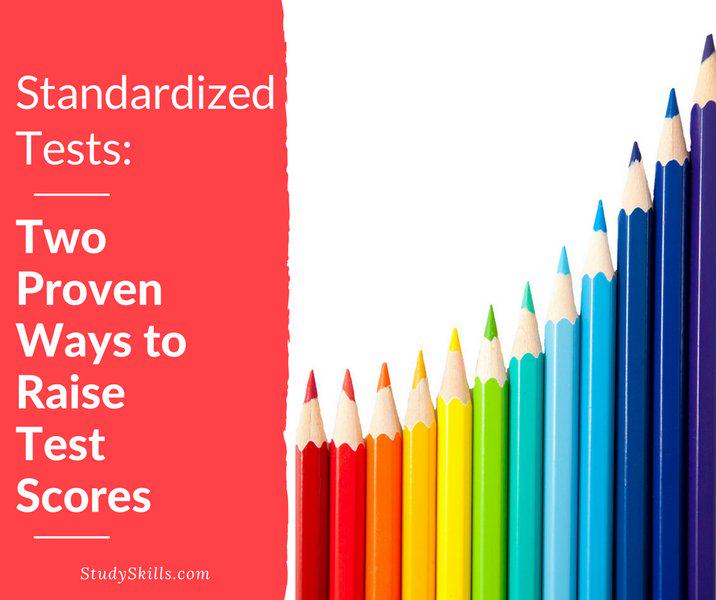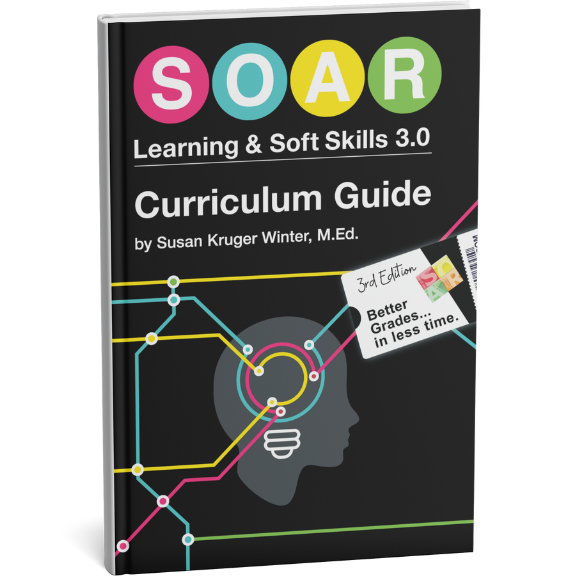Standardized Tests:
Two Proven Ways to Raise Test Scores
 Research consistently confirms there are two critical ways to raise test scores on standardized tests:
Research consistently confirms there are two critical ways to raise test scores on standardized tests:
-
- Build “cognitive flexibility” with metacognitive strategies.1 If students don’t have problem-solving strategies for learning content, well… they won’t learn it! Obviously.
- Teach the curriculum, not “to the test.” Teaching “to the test” –also known as “item teaching”– actually lowers test scores; it promotes narrow, rigid thinking.2,3 And, it’s directly opposed to item #1. Instead, students get better results when instruction is focused on the content represented on the test. This body of knowledge is typically known as your content standards.
The National Research Council says that teaching students how to ask questions is the key to successful problem-solving.1 As you will notice, the “A” in SOAR® stands for “Ask questions.” All metacognitive strategies in SOAR® use the process of “asking questions” as the primary way to learn new information.
Other Research-Validated Strategies to Raise Test Scores Include:
- Promote goal-setting and monitoring.4,5 The “S” in SOAR® stands for “Set goals.” Students learn a simple, yet comprehensive approach for “thinking forward” to create goals. SOAR® concludes with an “R” for “Record your progress,” where students learn to monitor their goals.
- Cultivate student reflection.6,7,8 SOAR® is built upon the understanding that metacognitive growth only happens through the process of reflection. All strategies are presented in a student-friendly manner that encourage self-reflection. Three (out of five) sections are specifically centered around self-reflection: Section 1–How Are You Smart?, Section 2-Set goals, and Section 5-Record your progress. Even Section 4-Ask questions requires student reflection to create the questions they will ask. In the SOAR® Multi-Media Teacher’s Guide, all lessons begin and end with a “spiral review,” specifically to promote reflection. “Reflection” very naturally becomes part of the class culture with SOAR®.
- Encourage self-evaluation of work.4,9,10 The most powerful element of “self-evaluation” in SOAR® is the Exit Presentation. As the name suggests, it is the final assessment where students: reflect on what they’ve learned, provide evidence of their learning, and describe how this learning will be helpful in the workplace. The long-term impact of the Exit Presentation cannot be overstated!
- Learn from mistakes.11,12 There truly is no better way to learn than from our mistakes! The most powerful strategy in Chapter 12, How to Take Tests is reviewing tests after they’ve been graded. The process does not improve the immediate test grade, but it makes an impact on future tests… and most importantly, on future learning and understanding.
- Teach how to take tests.13 “Tests” are their own genre of literacy. Chapter 12, How to Take Tests provides tips and practice on how to take a wide variety of tests. Some educators object to this, saying students must learn the content! Of course, genuine learning is the primary object of SOAR®. However, if a student is confused by certain elements of test-taking, their score will not reflect their true content knowledge, either. It’s in everyone’s best interest for students to know how to take a variety of tests.
Warning!
“Metacognitive” strategies are NOT helpful if students don’t know how and when to use them. This is the core problem with most “study skills” instruction. Skills are usually taught for one, isolated situation. Yet, students do not know when to use those skills again. Or, they’ve learned so many strategies, they can’t remember how to do any of them. We will never raise test scores if we over-complicate strategies.
With SOAR®, we focus on the one, basic, core strategy of learning… making connections. We then teach how to “ask questions” as the basic way to make learning connections. This simplification empowers students to use “metacognitive strategies” in a wide variety of situations… including high-stakes standardized tests!
Want to see your standardized test scores SOAR? Get more information on how to raise test scores here.
To our students’ success,
Susan Kruger, M.Ed.
Sources
1National Research Council. (2000). How people learn: Brain, mind, experience, and school. Washington, D.C.: National Academy Press.
2Linn, R.L. (2000). Assessments and accountability. Educational Researcher, 29(2), 4-16.
3Popham, J.W. (1999). Why standardized test scores don’t measure educational quality. Educational Leadership, 56(6), 8-15.
4Andrade, H.G. (2000). Using rubrics to promote thinking and learning. Educational Leadership, 57, 13-18.
5Stiggins, R.J. (1997). Student-centered classroom assessment. 2nd edition. Upper Saddle River, N.J.: Merrill.
6Meier, D. (1995). The power of their ideas: Lessons for America from a small school in Harlem. Boston: Beacon Press.
7Johnston, P.H. & Winograd, P.N. (1985). Passive failure in reading. Journal of Reading Behavior, 17(4), 279-301.
8Rief, L. (1990). Finding the value in evaluation: Self-evaluation in a middle school classroom. Educational Leadership, 47(6), 24-29.
9Wolf, D.P. (1989). Portfolio assessment: Sampling student work. Educational Leadership, 46(7), 35-39.
10Valencia, S.W. (1998). Literacy portfolios in action. Belmont, CA: Wadsworth.
11Guskey, T.R. (2003). How classroom assessments improve learning. Educational Leadership, 60 (5), 6-11.
12Stiggins, R. J. (2002). Assessment crisis: The absence of assessment for learning. Phi Delta Kappan, 83 (8), 758-765.
13Powell, S.D. (1999). Teaching to the test. The High School Magazine, 6 (6), 34-37.
Six Steps
Conquer the Chaos
Get Our Free Guide & Information on...
 How to Organize & Motivate Students for Success
How to Organize & Motivate Students for Success
"*" indicates required fields
Get Our FREE Curriculum Guide!
The SOAR® Curriculum
The most critical learning, organizing, and communication skills needed for school. Learn more here.
Who’s Using SOAR®?
SOAR® Guarantee
Click here to learn more.





